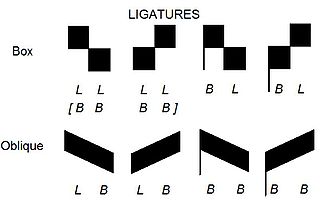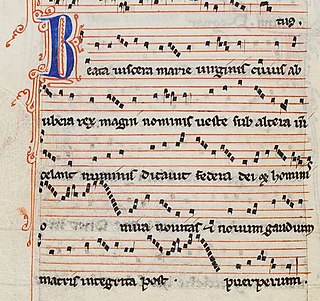Related Research Articles

Medieval music encompasses the sacred and secular music of the Western Europe during the Middle Ages, from approximately the 6th to 15th centuries. It is the first and longest era of Western classical music and followed by the Renaissance music; the two eras comprise what musicologists term as early music, preceding the common practice period. Following the traditional divisions of the Middle Ages, medieval music can be divided into Early (500–1150), High (1000–1300), and Late (1300–1400) medieval music.

In music notation, a ligature is a graphic symbol that tells a musician to perform two or more notes in a single gesture, and on a single syllable. It was primarily used from around 800 to 1650 AD. Ligatures are characteristic of neumatic (chant) and mensural notation. The notation and meaning of ligatures has changed significantly throughout Western music history, and their precise interpretation is a continuing subject of debate among musicologists.
Pérotin was a composer associated with the Notre Dame school of polyphony in Paris and the broader ars antiqua musical style of high medieval music. He is credited with developing the polyphonic practices of his predecessor, Léonin, with the introduction of three and four-part harmonies.
Organum is, in general, a plainchant melody with at least one added voice to enhance the harmony, developed in the Middle Ages. Depending on the mode and form of the chant, a supporting bass line may be sung on the same text, the melody may be followed in parallel motion, or a combination of both of these techniques may be employed. As no real independent second voice exists, this is a form of heterophony. In its earliest stages, organum involved two musical voices: a Gregorian chant melody, and the same melody transposed by a consonant interval, usually a perfect fifth or fourth. In these cases the composition often began and ended on a unison, the added voice keeping to the initial tone until the first part has reached a fifth or fourth, from where both voices proceeded in parallel harmony, with the reverse process at the end. Organum was originally improvised; while one singer performed a notated melody, another singer—singing "by ear"—provided the unnotated second melody. Over time, composers began to write added parts that were not just simple transpositions, thus creating true polyphony.

Ars antiqua, also called ars veterum or ars vetus, is a term used by modern scholars to refer to the Medieval music of Europe during the High Middle Ages, between approximately 1170 and 1310. This covers the period of the Notre-Dame school of polyphony, and the subsequent years which saw the early development of the motet, a highly varied choral musical composition. Usually the term ars antiqua is restricted to sacred (church) or polyphonic music, excluding the secular (non-religious) monophonic songs of the troubadours, and trouvères. However, sometimes the term ars antiqua is used more loosely to mean all European music of the thirteenth century, and from slightly before. The term ars antiqua is used in opposition to ars nova, which refers to the period of musical activity between approximately 1310 and 1375.

The conductus was a sacred Latin song in the Middle Ages, one whose poetry and music were newly composed. It is non-liturgical since its Latin lyric borrows little from previous chants. The conductus was northern French equivalent of the versus, which flourished in Aquitaine. It was originally found in the twelfth-century Aquitanian repertories. But major collections of conductus were preserved in Paris. The conductus typically includes one, two, or three voices. A small number of the conductus are for four voices. Stylistically, the conductus is a type of discant. Its form can be strophic or through-composed form. The genre flourished from the early twelfth century to the middle of thirteenth century. It was one of the principal types of vocal composition of the ars antiqua period of medieval music history.
Franco of Cologne was a German music theorist and possibly a composer. He was one of the most influential theorists of the Late Middle Ages, and was the first to propose an idea which was to transform musical notation permanently: that the duration of any note should be determined by its appearance on the page, and not from context alone. The result was Franconian notation.
Johannes de Garlandia was a French music theorist of the late ars antiqua period of medieval music. He is known for his work on the first treatise to explore the practice of musical notation of rhythm, De Mensurabili Musica.

In medieval music, the rhythmic modes were set patterns of long and short durations. The value of each note is not determined by the form of the written note, but rather by its position within a group of notes written as a single figure called a "ligature", and by the position of the ligature relative to other ligatures. Modal notation was developed by the composers of the Notre Dame school from 1170 to 1250, replacing the even and unmeasured rhythm of early polyphony and plainchant with patterns based on the metric feet of classical poetry, and was the first step towards the development of modern mensural notation. The rhythmic modes of Notre Dame Polyphony were the first coherent system of rhythmic notation developed in Western music since antiquity.
Marchetto da Padova was an Italian music theorist and composer of the late medieval era. His innovations in notation of time-values were fundamental to the music of the Italian ars nova, as was his work on defining the modes and refining tuning. In addition, he was the first music theorist to discuss chromaticism.

Mensural notation is the musical notation system used for European vocal polyphonic music from the later part of the 13th century until about 1600. The term "mensural" refers to the ability of this system to describe precisely measured rhythmic durations in terms of numerical proportions between note values. Its modern name is inspired by the terminology of medieval theorists, who used terms like musica mensurata or cantus mensurabilis to refer to the rhythmically defined polyphonic music of their age, as opposed to musica plana or musica choralis, i.e., Gregorian plainchant. Mensural notation was employed principally for compositions in the tradition of vocal polyphony, whereas plainchant retained its own, older system of neume notation throughout the period. Besides these, some purely instrumental music could be written in various forms of instrument-specific tablature notation.
Discant, or descant (descant), originated as a style of liturgical setting in the Middle Ages, associated with the development of the Notre Dame school of polyphony.
Johannes de Muris, or John of Murs, was a French philosopher, astronomer, mathematician, and music theorist best known for treatises on the ars nova, titled Ars nove musice.
Johannes de Grocheio was a Parisian musical theorist of the early 14th century. His French name was Jean de Grouchy, but he is best known by his Latinized name. He was the author of the treatise Ars musicae, which describes the functions of sacred and secular music in and around Paris during his lifetime.
Falsobordone is a style of recitation found in music from the 15th to the 18th centuries. Most often associated with the harmonization of Gregorian psalm tones, it is based on root position triads and is first known to have appeared in southern Europe in the 1480s.

The Missa L'homme armé super voces musicales is the first of two settings of the Ordinary of the Mass by Josquin des Prez using the famous L'homme armé tune as their cantus firmus source material. The setting is for four voices. It was the most famous mass Josquin composed, surviving in numerous manuscripts and print editions. The earliest printed collection of music devoted to a single composer, the Misse Josquin published by Ottaviano Petrucci in 1502, begins with this famous work.
Jehan Vaillant was a French music composer and theorist. He is named immediately after Guillaume de Machaut by the Règles de la seconde rhétorique, which describes him as a "master … who had a school of music in Paris". Besides five pieces of music surviving to his name, he was also the author of a treatise on tuning. With Grimace and F. Andrieu, Vaillant was part of the post-Machaut generation whose music shows few distinctly ars subtilior features, leading scholars to recognize Vaillant's work as closer to the ars nova style of Machaut.
De Mensurabili Musica is a musical treatise from the early 13th century and is the first of two treatises traditionally attributed to French music theorist Johannes de Garlandia; the other is de plana musica. De Mensurabili Musica was the first to explain a modal rhythmic system that was already in use at the time: the rhythmic modes. The six rhythmic modes set out by the treatise are all in triple time and are made from combinations of the note values longa (long) and brevis (short) and are given the names trochee, iamb, dactyl, anapest, spondaic and tribrach, although trochee, dactyl and spondaic were much more common. It is evident how influential Garlandia's treatise has been by the number of theorists that have used its ideas. Much of the surviving music of the Notre Dame School from the 13th century is based on the rhythmic modes set out in De Mensurabili Musica.

Ars cantus mensurabilis is a music theory treatise from the mid-13th century, c. 1250–1280 written by German music theorist Franco of Cologne. The treatise was written shortly after De Mensurabili Musica, a treatise by Johannes de Garlandia, which summarised a set of six rhythmic modes in use at the time. In music written in rhythmic modes, the duration of a note could be determined only in context. Ars cantus mensurabilis was the first treatise to suggest that individual notes could have their own durations independent of context. This new rhythmic system was the foundation for the mensural notation system and the ars nova style.
Petrus de Goscalch is a composer from the papal choir at Avignon of whom only one composition, "En nul estat", survives in the Chantilly Codex, but who may be significant as the possible author of the third part of The Berkeley Treatise of 1375.
References
- ↑ Reinhard Strohm, Bonnie J. Blackburn Music as Concept and Practice in the Late Middle Ages 0198162057 2001 "The Berkeley Treatise is an anonymous five-part compilation of works on fundamentals and mode, discant, mensuration (this part a version of the Libellus cantus mensurabilis secundum Johannem de Muris), musica speculativa, and tuning ... Its third part bears the date 1375 (and in a concordant manuscript an attribution to Goscalcus Francigena, possibly identical with the composer Goscalch known through one ballade in Chantilly, Musee Conde, MS 564). It is important for its exposition of the theory of hexachords built on notes other than C, F, and G..."